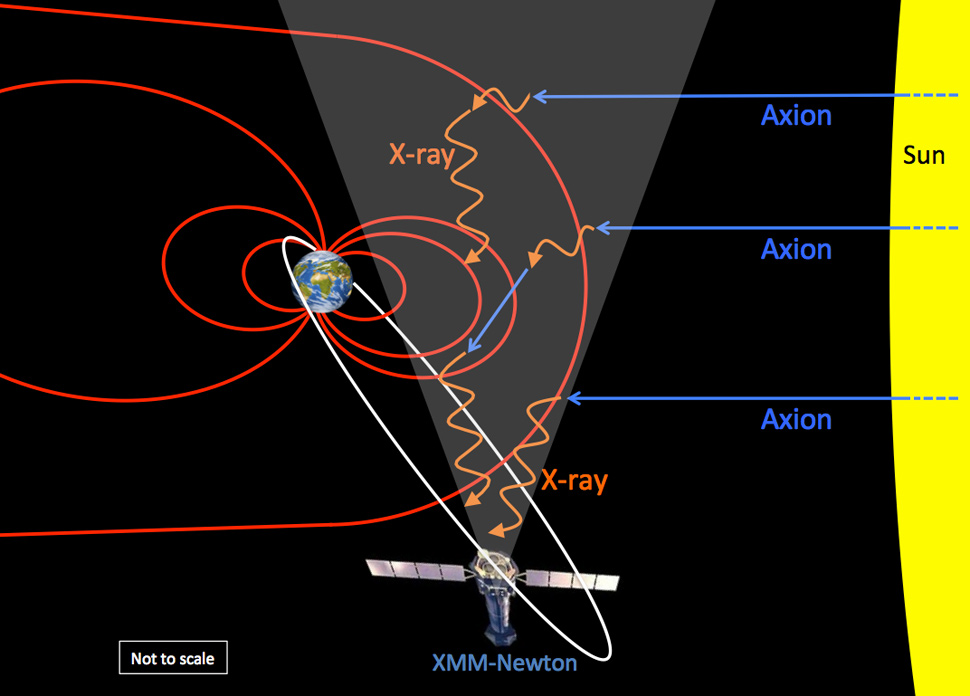Axions are a fascinating theoretical particle that has emerged as a leading candidate in the quest to understand dark matter, the elusive substance believed to make up a significant portion of the universe’s mass. Despite having never been directly observed, axions have captured the interest of physicists, as they have the potential to unlock critical answers in particle physics. Recent research involving axion detection has provided a breakthrough, suggesting that quasiparticles may serve as effective tools in identifying these particles. This attracts attention not only for its implications in astrophysics but also for its relevance to quantum technologies and advanced material science. As we push the boundaries of our understanding of the cosmos, axions stand as a pivotal puzzle piece in the greater picture of the universe.
Often referred to as hypothetical particles, axions are considered crucial to comprehending the enigmatic realm of dark matter, which remains one of the significant unsolved mysteries of modern physics. These particles have been theorized as a means to explore fundamental questions within the field of particle physics, and their detection could reveal much about the universe’s history and composition. In light of this, researchers are exploring innovative methodologies to confirm the existence of these elusive candidates, leveraging advancements in nterdisciplinary approaches and state-of-the-art materials. The study of axion-based quasiparticles not only holds promise for scientific discovery but also paves the way for the development of groundbreaking quantum technologies. As developments in axion research continue to unfold, scientists are optimistic about potential breakthroughs that could reshape our understanding of the universe.
Understanding Axions: The Leading Candidate for Dark Matter
Axions, theorized to be extremely light and stable particles, form an intriguing part of dark matter research. Their existence offers potential explanations for some of the universe’s most enigmatic phenomena, including galaxy formation and cosmic background radiation. Despite their importance, axions have remained undetected, prompting researchers to develop innovative methods for identification within particle physics. Their characteristics hint that they could resolve the pressing questions about the cosmos, particularly concerning the mass composition and the elusive nature of dark matter.
Recent studies have sparked renewed interest in axions, especially in light of their predicted properties that align with observed cosmic phenomena. The race to confirm their existence hinges on sophisticated experimental techniques designed to detect their presence indirectly through energy fluctuations. As dark matter constitutes roughly 85% of the universe’s total mass, establishing a connection between axions and observable effects would signify a monumental leap in our understanding of the cosmos.
The Role of Quasiparticles in Axion Research
Quasiparticles have emerged as pivotal tools in the hunt for axions and provide a significant edge in dark matter detection. These collective excitations can mimic the properties of axions and serve as effective detectors to reveal the interactions initiated by dark matter axions. By utilizing materials like manganese bismuth telluride, researchers have created platforms for quasiparticles that allow them to explore experimental dynamics. This integration of condensed matter physics with high-energy physics paves the way for new methods of detecting otherwise elusive particles.
Researchers are now harnessing the characteristics of axion quasiparticles to unlock fundamental insights into their behavior and interactions. By leveraging advanced detection techniques, scientists can observe intricate actions that occur when axions interact with these engineered materials. This innovative approach not only furthers our understanding of axions but may also lay the groundwork for groundbreaking advancements in quantum technologies, potentially revolutionizing the way we detect and analyze dark matter.
Innovative Techniques in Axion Detection
The experimental strategy to detect axions through quasiparticles involves a combination of precision nano-fabrication and sophisticated measuring techniques. Researchers have developed methods utilizing ultrafast laser optics to induce and capture movements of axion quasiparticles, providing real-time data about their dynamic nature. This multidisciplinary approach blends material chemistry and condensed matter physics, showcasing the ability of quantum materials to function as critical technologies in physics research, especially concerning axion detection.
Moreover, the novel axion detection framework described as a ‘cosmic car radio’ exemplifies the ingenuity behind this research. This metaphor signifies how finely tuned detection techniques will allow scientists to listen to specific frequencies emitted by axion interactions, enabling them to capture dark-matter signals that have eluded detection in previous studies. Such developments not only push the boundaries of particle physics but also open doors for practical applications in quantum technologies and beyond.
The Promise of Quantum Technologies in Dark Matter Research
Quantum technologies are at the forefront of the new scientific era, especially in the context of dark matter research. By fostering the use of axion quasiparticles in experiments, researchers are effectively investigating the potential applications of quantum materials in practical settings. The intricate interplay between light and matter through phenomena such as axion polaritons may lead to innovations in optical applications and a deeper comprehension of quantum states.
As the research moves forward, the interplay of high-energy physics and quantum technologies stands to revolutionize dark matter detection methodologies. The possibility of utilizing axions as a new detection mechanism underscores the potential for unprecedented breakthroughs in particle physics. By refining experimental conditions and exploring new properties of axions, researchers aim to achieve a precise understanding that could unlock the mysteries of dark matter and redefine our scientific landscape.
Collaborations Driving Dark Matter Research Forward
The advancement of dark matter research, particularly regarding axions, is heavily reliant on collaborative efforts across institutions. The interdisciplinary nature of the work involves partnerships between universities, laboratories, and international teams, pooling expertise in various fields such as particle physics, material science, and quantum technology. The collective insight from these collaborations fosters a rich environment for innovation, ultimately leading to significant breakthroughs in our understanding of the universe.
Prominent figures such as Nobel laureate Frank Wilczek have recognized the importance of these collaborative networks in enhancing experimental capabilities for axion detection. By bringing together diverse perspectives and methodologies, researchers are equipped to tackle one of physics’ most profound enigmas—the nature of dark matter. The synergy of shared knowledge and resources not only accelerates the discovery of axions but also promotes the emergence of new theories and technologies in the quest for understanding the cosmos.
Precision Nano-Fabrication: Crafting Materials for Discovery
Precision nano-fabrication has proven to be a crucial technique in the experimental efforts to detect axions. The creation of materials such as manganese bismuth telluride into precise two-dimensional structures allows for the development of environments conducive to the formation of axion quasiparticles. This meticulous engineering enables researchers to fine-tune material properties, enhancing their capabilities to observe intricate dynamics related to dark matter interactions.
The challenges of working with air-sensitive materials highlight the meticulous nature of this research. Researchers employed sophisticated methods over several years to develop and optimize these structures, exemplifying the dedication and technical skill required in modern particle physics experiments. Such efforts are essential not only for the detection of axions but also for advancing the field of quantum technologies that hinge on the understanding and manipulation of quantum states.
Future of Axion Research and Technological Applications
The future of axion research promises exciting developments with significant implications for both theoretical physics and practical technologies. As experimental techniques continue to refine detection capabilities, researchers envision their work leading to concrete discoveries within the next decade. The potential to confirm the existence of dark matter through axions signifies not only a scientific victory but could catalyze advancements across various technological sectors, from quantum computing to advanced imaging systems in research.
Researchers like Jan Schütte Engel emphasize the importance of ongoing exploration into axion-dark matter interactions. This ongoing commitment could unlock a wealth of knowledge regarding the structure and behavior of the universe. The pursuit of axion detection serves as a profound illustration of how foundational research can yield transformative technologies, reshaping our understanding of both the cosmos and our applied sciences.
The Interplay of Particle Physics and Cosmology
The intersection of particle physics and cosmology is essential in deciphering the complexities surrounding dark matter. This interplay is exemplified by the theoretical underpinnings of axions, as they provide a bridge between the micro-world of subatomic particles and the macro-universe we inhabit. Understanding how fundamental particles interact and contribute to cosmic phenomena is vital for answering questions about the origins of dark matter and energy, providing a holistic perspective on the universe.
Furthermore, advancements in axion research reveal how particle physics can adapt theories and methodologies to modern cosmological challenges. As theories are put to the test through innovative experiments, the results may redefine our concepts of mass, gravity, and the very fabric of space-time. Thus, the study of axions not only informs our understanding of dark matter but also enriches the broader narrative of scientific inquiry across disciplines.
The Advances in Theoretical Models Supporting Axions
Recent advances in theoretical models have bolstered the case for axions, enhancing their status as a leading dark matter candidate. These models help bridge experimental observations with the elusive characteristics expected of dark matter. Critical to this effort is the exploration of quantum fields and their interactions, providing explanations that fit seamlessly with current astrophysical data regarding galaxy rotation and cosmic microwave background radiation.
By investigating varying strategies to model axions’ properties, researchers can refine theoretical predictions about their behavior. This iterative process between theory and experiment is crucial for advancing dark matter research, as successful detection of axions would serve as validation for these theoretical approaches. Such advancements reinforce the collaborative pursuit of knowledge, driving scientific inquiry deeper into the nuances of particle physics and the cosmic structure.
Frequently Asked Questions
What are axions and how are they related to dark matter?
Axions are hypothetical elementary particles proposed as a solution to the dark matter problem in the universe. They are theorized to be extremely light and stable, possibly making up a significant portion of dark matter, which constitutes about 85% of the universe’s mass. Their unique properties could help explain some fundamental questions in particle physics.
How do axions function as quasiparticles in dark matter detection experiments?
In recent experiments, researchers have identified axion quasiparticles, which are simulations of axion particles. When dark matter axions interact with certain materials, they can excite these quasiparticles. By detecting such excitations, scientists can infer the presence of actual axions, thus advancing the search for dark matter.
What recent advancements have been made in axion detection within particle physics?
A groundbreaking experiment led by researchers from Harvard and King’s College London has demonstrated how quasiparticles can be utilized to hunt for axions. This study, published in Nature, has opened new avenues for developing dark matter detectors that leverage unique materials like manganese bismuth telluride, potentially leading to significant advancements in quantum technologies.
Why are axions considered a key element in quantum technologies?
Axions are considered pivotal in quantum technologies due to their properties that can lead to novel interactions between light and matter. The recent observations of axion quasiparticles are expected to stimulate the development of new optical applications and refined measurement tools, essential for both particle physics and technological innovations.
What is the significance of axion quasiparticles in modern cosmology?
Axion quasiparticles play a crucial role in modern cosmology by providing insight into the elusive nature of dark matter. Their detection could validate theories regarding the universe’s composition and history, crucial for understanding fundamental aspects of physics and the evolution of the cosmos.
How can researchers continue to study axions for future breakthroughs?
Researchers aim to refine their methods for probing axion quasiparticle properties, enhancing experimental conditions to increase detection precision. Future experiments focusing on axion dark matter will potentially provide key insights, benefiting the particle physics community and enhancing our understanding of fundamental forces.
| Key Points |
|---|
| Theoretical existence of axions as dark matter candidates; crucial for understanding the universe’s composition. |
| Groundbreaking experiment by Harvard and King’s College to confirm axions’ presence using quasiparticles. |
| A new model linking axion quasiparticles to actual particles, enhancing dark matter detection capabilities. |
| Manganese bismuth telluride utilized for creating axion quasiparticles in a controlled environment. |
| Innovative measurement tools allowed visualization of quasiparticles’ behavior, confirming theoretical ideas. |
| Future experiments aim to hone methods for detecting dark matter, with advances expected within 15 years. |
| Research funded by prominent scientific organizations underlines the importance of axion studies in particle physics. |
Summary
Axions are at the forefront of modern physics research, as recent breakthroughs provide substantial evidence for their existence as fundamental particles theorized to account for dark matter. This research, led by an innovative team from Harvard and King’s College, exemplifies how advancements in quantum materials and experimental techniques can enhance our understanding of the cosmos. By confirming the existence of axion quasiparticles, the study opens new avenues for exploring dark matter, a critical component of our universe that remains elusive. As researchers continue to refine their methods, the potential for discovering the nature of dark matter through axions becomes increasingly feasible, marking an exciting chapter in astrophysics.




